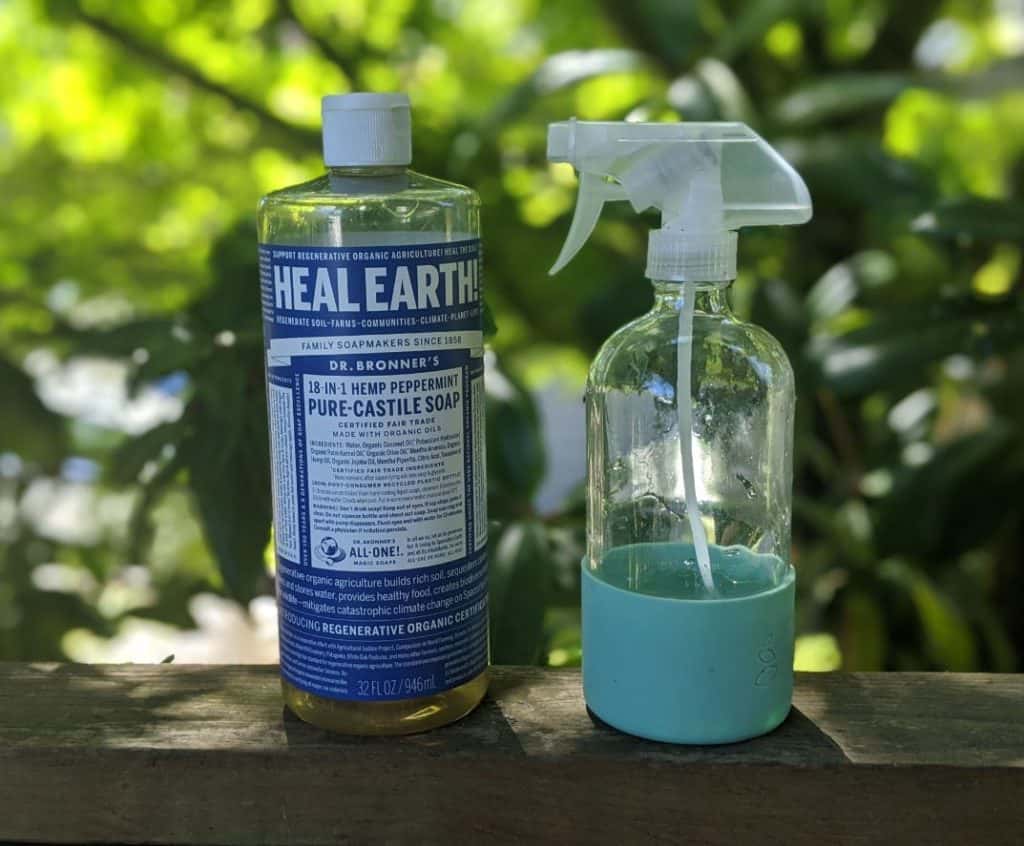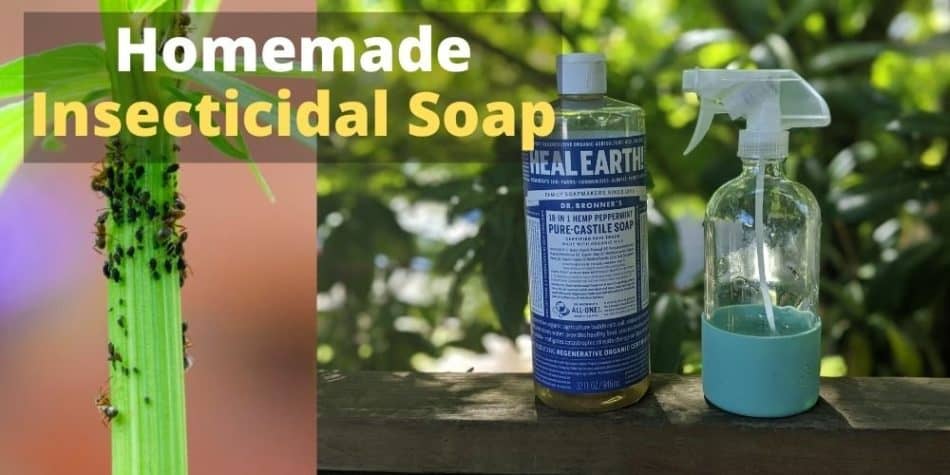Pests are an inevitable annoyance in any home and organic garden. Although it can feel like things are going wrong, pests are a great sign of a healthy ecosystem.
We just need to get rid of the pest population so that your plants can continue to grow.
If you don’t want to use a chemical spray in your vegetable or organic garden then we need to use a safe and effective way of killing your pests. A simple solution is creating your own homemade insecticidal soap spray to get rid of the soft bodied pests.
What Is Insecticidal Soap?
Given the numerous options of insecticide spray at your local garden supply store that are readily available. What even is insecticidal soap? Is it the same as these pre-mixed chemical sprays?
Insecticidal soap, also known as horitcultural soap, is plant safe soap that can be diluted in water and sprayed on insects. Castile soap is frequently recommended as insecticidal soap as these soaps are made from vegetables and typically fragrance and detergent free. Castile soap is plant, pet, and child safe making it a versatile and effective option for containing a pest infestation.
The goal of insecticidal soap is to get rid of the pests and not damage the plant. So lets go over the recipe for homemade insecticidal soap that kills pests but is safe for your plants.
Here’s a video where I show each step for creating a homemade Dr. Bronner’s insecticidal soapy spray.
The rest of the video shows how this spray works well on getting rid of aphids.
Dr. Bronner’s Insecticidal Soapy Spray Recipe
Dr. Bronner’s is a highly recommend brand of castile soap to use when creating an insecticidal spray. The peppermint castile liquid soap is the most popular option since peppermint is a natural insect repellent. Not to mention it smells quite nice.

Castile soap is made from vegetable oils which is what you want to use since these soaps will not damage your plants or soil.
DO NOT use dish soap especially ones with fragrances or degreasers for your insecticidal soap spray.
Fragrances and degreasers may harm your plants and soil so avoid using these soaps at all costs. You will get rid of the pests but you might also get rid of your plant if the soap has toxic ingredients.
Mixing Instructions:
- Simply mix 1 tablespoon of liquid castile soap per quart of water.
- Use warm water to promote mixing.
- Pour the mixture into a spray bottle.
- Shake thoroughly before spraying your plants.
- Pro-tip: Use a half gallon pump sprayer to treat larger plants or infected areas.
Application Instructions:
- Apply the insecticidal soap spray onto a small test area a day or two before treating the entire infestation. I’ve never had an issue with the Dr. Bronner’s insecticidal spray but I just want to make sure that you don’t ruin your plants if there’s a negative reaction.
- The best time to use your soap spray is in the evening. The morning and mid-day are bad times to apply this spray since it will may cause your plant leaves to burn. Remember this spray sits on your plant’s leave so the water can act as a magnifying glass on your leaf surface.
- Insecticidal soap spray only works if the aphids are sprayed directly. So be sure to spray directly onto the pests and coat them thoroughly.
- Made sure to spray both sides of each leaf and any folds or curls otherwise those aphids will continue to come back.
- You can rinse off the soapy spray from your plants leaves after an hour if you like. I have left mine on my plants with no negative side effect. However, if the next day is going to be hot then it might be worth spraying your plants leaves clean of any remaining soap.
- Re-apply the soapy spray every 2 to 3 days for about 2 weeks. Make sure the aphids are completely gone otherwise you risk them coming back since they can reproduce quickly.
How Insecticidal Soap Spray Works
The great news is that soapy water does kill soft bodied pests such as aphids when sprayed directly onto them. However, the reason why soapy water works is a little tricky to answer.
There are 2 popular theories that gardeners and scientists think cause soapy spray to work as an effective aphid killer.
- According to Colorado State University and the University of California, the soapy spray removes the protective wax on the insect’s body causing death through excess loss of water.
- However, there is also a common belief that the soapy spray helps keep water stuck to the insect’s body which causes it to suffocate. This is due to the fact that insects breathe through small vents on their bodies called spiracles.
Unfortunately, I could not find any conclusive reason why this spray works. Comment down below or message me if you figure out why this soap spray works at killing soft bodied insects.
Regardless of exactly how insecticidal soap works, the great news is that insecticidal soap does work at getting rid of soft bodied insects.
Ready To Use Insecticidal Soap
Commercial products or ready-to-use insecticidal soap are available at most garden centers. These will either come pre-diluted in the sprayer or in a concentrated bottle.
These are a great option if you are not someone who wants to create a homemade or DIY soap spray solution. However, these commercial products may have trace elements or chemicals that can be more harsh than the simple Dr. Bronner’s solution.
Most commercial insecticidal soap will be safer to use than insecticides or pesticides since those are extremely toxic.
Conclusion
Creating homemade insecticidal soapy spray is a simple, cheap, and effective way to get rid of soft bodied pests such as aphids.
There are commercial products available in stores which are another great alternative to harmful pesticides and insecticides. Use what works for you and be sure to test each spray on a small area before using it on your entire garden.

